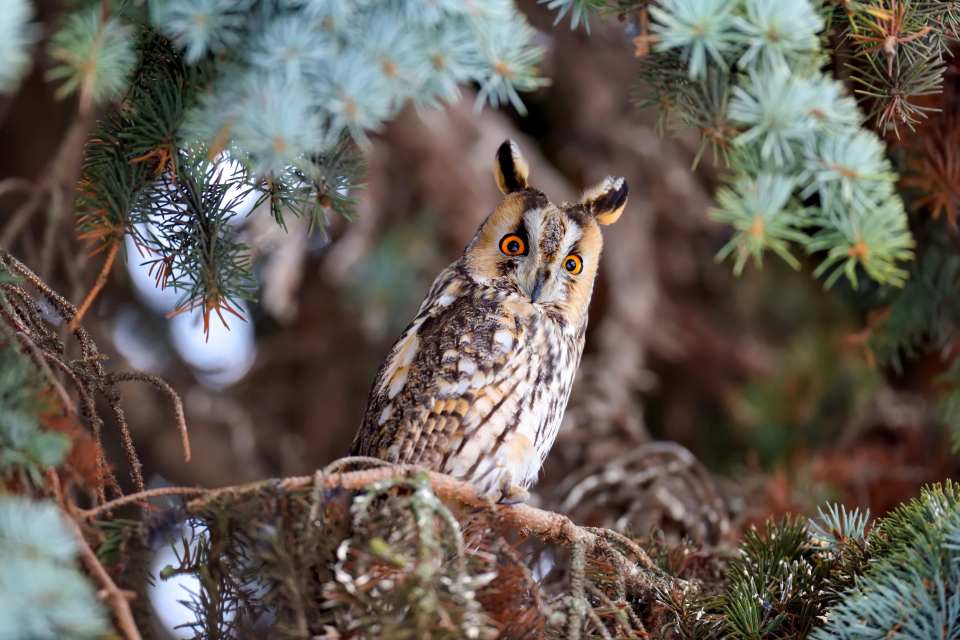Species Guide: Little Owl (Athene noctua)
Family: Strigidae
The Little Owl (Athene noctua) is a small, stocky owl native to much of Europe, North Africa, and large parts of Asia. It is familiar in both wild and human-modified landscapes and is well known culturally as the “owl of Athena” (or Minerva), a long-standing symbol of wisdom. The species has a broad range and is generally assessed as Least Concern on the IUCN Red List, though local populations sometimes decline.
Appearance
The Little Owl has a flat-topped head (no ear tufts), a compact body, relatively short wings and tail, yellow eyes, and prominent pale “eyebrows” that give a stern or frowning expression. Plumage is mottled brown and white, providing good camouflage on tree trunks, rocks, and walls.
Male & Female
There is little obvious sexual dimorphism; males and females look very similar in plumage. Females are typically slightly larger and heavier on average than males, but plumage patterns and colors are not reliably different between the sexes.

Juvenile
Juveniles are duller and less distinctly spotted than adults; they lack the strong white crown spots and pronounced facial markings of mature birds. Young birds often have fluffier feathers and a more muted overall tone while they mature.

Diet
Little Owls are opportunistic, mixed feeders. Their diet includes large insects (beetles, grasshoppers, crickets), earthworms and other invertebrates, and small vertebrates such as mice, voles, shrews, small birds, amphibians, and reptiles. The exact composition varies seasonally and regionally in some areas, mammals form a substantial part of the biomass taken, while in others, insects dominate. They hunt from perches, drop to the ground, and will also capture prey on the wing.
Habitat
The Little Owl prefers open or semi-open landscapes with hunting perches and nesting cavities: farmland with hedgerows, orchards, parkland, open woodlands, steppes, rocky outcrops, rural buildings, and sometimes cliffs or rabbit burrows. It adapts well to a human-dominated countryside where suitable nest sites and prey are available.

Resident
Introduced
Behavior
Territoriality & daily activity
Little Owls are mainly crepuscular and nocturnal but can be active during daylight, especially at dusk and dawn. They are territorial; males commonly hold and defend territory year-round. Pairs may remain bonded across seasons.
Calls
Their typical call is a plaintive, querulous “kiew–kiew” or “kew” series; they also make loud, ringing whistles, trills, barks, and chattering calls used in mate contact, territorial defense, and alarm. Pairs sometimes duet during the breeding season.
Breeding & life cycle
Fledging: chicks fledge at roughly 7 weeks; parental feeding continues after leaving the nest. Usually one brood per year; a second may occur if food is abundant. Juveniles usually disperse relatively short distances (commonly within ~20 km).
Nesting: cavity nesters use tree holes, wall cavities, nest boxes, old buildings, cliffs, and even rabbit burrows.
Clutch & incubation: typically 3–5 white eggs laid in spring; incubation is ~28–29 days by the female while the male supplies food.
Biometrics2
| Length | 21-23 cm |
| Wing Span | 54-58 cm |
| Body Weight | 140-220 grams |
| Longevity3 | ~3-13 Years |
Natural Predators
Predators vary by location and include larger owls (e.g., long-eared and tawny owls), raptors (buzzards, goshawks), foxes, martens, and domestic/feral cats when little owls roost or nest close to the ground or in buildings. Eggs and nestlings are vulnerable to corvids and small mammalian predators. Adult little owls are agile and rely on camouflage, vigilance, and secluded nest sites to reduce predation.
Relationship to Humans
The little owl has been entwined with human culture for millennia: it was closely associated with the Greek goddess Athena (and Roman Minerva) and appears on ancient Athenian coinage, hence the bird’s enduring symbolic link to wisdom and learning. In folklore and literature across its range, the owl appears in omens, tales and as a household figure; perspectives vary by culture from reverence to superstition. Introductions by humans have placed the species outside its original range (e.g., Britain, New Zealand), with mixed ecological effects.

Conservation Status
Global status: The IUCN currently lists the little owl as Least Concern because of its very large range and sizeable overall population. However, trends differ regionally.
Regional variation: Some countries and local areas report declines and have placed the species on national red lists (for example, declines have been reported in parts of northern and western Europe). Local threats include agricultural intensification (loss of hunting habitat and nest sites), removal of old trees and hedgerows, pesticide-driven declines in prey, collisions with vehicles, persecution, and nest-site loss. Conservation measures such as nest-box programs, preserving old trees and countryside features, and less intensive farmland management can and have helped local populations recover.
U.K.
Conservation Status

Global
Conservation Status

Related Articles







Ad Space
References
- Lovette, I. et al. (2016) The Cornell Lab of Ornithology, handbook of bird biology. Third edition. Chichester: Wiley. [Accessed 24/10/2025]
CITATIONS
- By IUCN Red List of Threatened Species, species assessors and the authors of the spatial data., CC BY-SA 3.0, [Accessed 24/10/2025] ↩︎
- RSPB [Accessed 24/10/2025] ↩︎
- BTO [Accessed 24/10/2025] ↩︎







